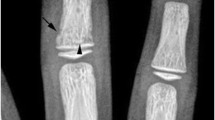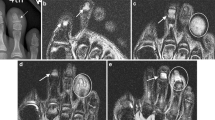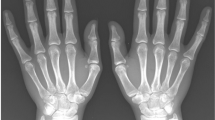Abstract
The authors describe the MR features of a case of microgeodic phalangeal syndrome in a 9-year-old boy. Roentgenograms showed multiple small areas of osteolysis in the middle phalanx of the right index finger. T1-weighted MR images showed lesions with diffuse low signal intensity not only in this phalanx but also in other phalanges. These lesions exhibited high signal intensity on T2-weighted images. Contrast- enhanced T1-weighted images showed a wide non-enhancing area in the middle phalanx of the index finger.
Similar content being viewed by others
Author information
Authors and Affiliations
Additional information
Received: 26 September 2000 Revision requested: 2 November 2000 Revision received: 25 November 2000 Accepted: 27 November 2000
Rights and permissions
About this article
Cite this article
Yamamoto, T., Kurosaka, M., Mizuno, K. et al. Phalangeal microgeodic syndrome: MR appearance. Skeletal Radiol 30, 170–172 (2001). https://doi.org/10.1007/s002560000321
Issue Date:
DOI: https://doi.org/10.1007/s002560000321




